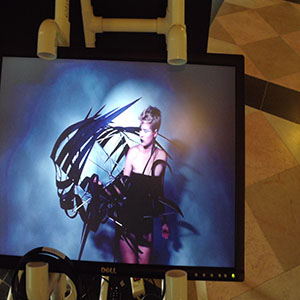Imagining Worlds Class Talk About World Building Exhibit
The lobby of the SCI building at University of Southern California’s School of Cinematic Arts had been transformed for over a week for the Science of Fiction Festival. The large TV monitors told about a distinct facet in an elaborate world. PVC tubes were built up to resemble trees, the green leaves are cards with words and phrases on them.
In the background, a recording of a man speaks poetically and solemnly about the land he is from. In the center of the room is a suitcase filled with, brochures, souvenirs and plane tickets. Wrapped around a mannequin is an apparatus; part wardrobe, part machine.

Professor Alex McDowell developed the concept of world building, the idea of creating the customs and culture of a fictitious society before creating characters and a script.
In his class IML 599: Imaging Worlds: Narrative Design Across Disciplines from the spring and fall 2014 semesters, students built a society based on the characteristics of both Los Angeles and Rio de Janeiro. The society is called Rilao, the students of McDowell’s classes devised every intricate detail based on research that they did on both cities.
Professor McDowell developed the idea of creating worlds from his work on the movie “Minority Report” according to Derek Passmore, a videographer of McDowell’s word building projects. McDowell believes that starting a story with a script does not fully exploit the possibilities of a narrative world. Building a world around a plot line gives story developers more materials to work with, according to McDowell.
“I’ve been developing this approach as a practice as a designer for about 15 years now,” he said. “It comes out of my experience in film.”
His method lead a diverse group of students to the Rilao exhibit. The dim lit room highlighted the informative media sequences that play on the ipads and tablets propped on the PVC trees. Every project is an artifact that give insight to a fictitious world created by students from USC and other universities around the world.
SEE MORE: Science of Fiction Festival Creates Imaginary City
Creating this project required computer programming, narrative storytellingand digital technology. Evangelos Pantazis, a PhD student in Engineering and Architecture programmed and designed a game that allowed exhibit viewers to create structures in Rilao.
“It’s called tetra forming,” said Pantazis. “The concept behind it is the people of Rilao are extending the territory of Rilao by building structures,”
An Oculus Rift and a videogame controller allows viewers to create the world just like McDowell’s students. The game Pantazis was built via Unity, type of software used to create videogames.
The Suitcase
Among the digital and vibrant images is a lone suitcase. This project is considered to be both traditional and very complex to McDowell.
“In my opinion the suitcase points towards what futures of a script might look like,” said McDowell. Vistiors of the exhibit must look at the objects in the suitcase and figure out for themselves the background of the person who owned the suitcase, according to Passmore. Murilo Hauser, a second year Screenwriting MFA student used his experience with traveling to help him create the project.
“It’s your job now to explore it’s contents and determine where it came from and who it belongs to,” said Hauser.

Carnival in Rilao
International schools contributed to the exhibit by making videos, according to Passmore. The Superior School of Marketing (ESPM) made a video about how the festival Carnival would look like in Rilao.
“We created this story based on Rilao history and Rilao mythology,” Pedro Curi, a professor at ESPM. Curi was the coordinator of the project and he worked with students to create a story and do filming.
“To create Rilaoan Carnival, we researched the story of Rilao and also the Carnival of Venice, the Carnival of Rio, different kinds of Carnivals and Carnival all around the world,” he said.
Nightmares of the Plauge
The society has a historical events, one of which was a plague. The class decided what year these events would take place, according to Mischa Cantu, a second year grad student in Film and TV Production. Cantu created a project named “The Plauge Doctors” a historical event influenced by the Venetian masks of Carnival, Spanish Influenza and body anxiety. The doctors visited Rilao while the citizen were enduring a plague, according to Cantu.
“They were originally these medieval doctors that would put herbs at the tip of their beak so that they wouldn’t have to smell the rotting bodies around them,” she said. “It kind of has a really terrifying aesthetic to it,”
These “masked elites” causes a lot of body anxiety, upset feelings and nightmares to the natives, according to Cantu. With the aide of projectors, she showed the dream sequences the natives would have.
“I got a lot of archival footage of monkeys and hamsters being experimented with radiation on including all the stuff in the [1920s], which is the time Rilao experienced their plague, from that was able to build a weird dream projected scenario,” Cantu said.
The History of Rilao: The Lao Chapters
Project ideas required group members to have multiple skills, according to students who helped create the exhibit. Bryan Edelman a third year MFA student in Interactive Media and Game Programs worked with Eric Adrian Marshall, who has an MFA in Film and TV Production along with two other students to make the project named “The Lao Chapters.” People that he worked with did audio and music editing and audio design as well as animations.
Their project told the history of the island of Rilao through the founder, Raymond Lao. Viewers can see the project through an Oculus Rift.

“It shows a video of Rilao like come to Rilao, it’s this fantastic place,” said Edelman. “But then, everything goes to static and things start going a little crazy. Then it gently brings you into this zen area where you float this pristine water up to this ominous and beautiful tree as you unlock these different diaries of his and really hear about what Raymond Lao thinks of Rilao,”
The project required traditional film technology, a green screen, lighting and a casting call for the lone character, according to Marshall.
“The biggest challenge with any project is directing the actor,” he said. “The actor does not have anything to play off of, they’re not on a location that inspires them, they’re on green screen. So getting the right performance is that much more difficult.”
Using 3D modeling software like Unity, Edelman could augment the footage of the actor standing in front of a green screen and change it into a holographic figure floating in front of a tree on the shore of an island. Accompanied with the Oculus Rift and audio coming through external headphones, the leader stands right before the participant, gold orbs come into view as they turn their heads right or left.
Robotic Fashion: The Exoskeleton
In the region of Rilao, there is a culture of expressive robotics. The Exoskeleton is a kinetic piece according to Lauren Fenton, a sixth year PhD student in Media Arts and Practice.
“It reacts to the muscle movements of the person who wears it and can open up these branches, these metal struts or close around a person,” she said.
Visiting a Stem Neighborhood and The Fly Over Experience
In Rilao, a type of housing called Stem buildings are inspired by the favelas in Rio, according to Fenton.
“That’s like a model of community ground up architecture,” said Fenton, “Based on that idea, we developed this model for stacking architecture where people just keep building floors on top of other floors and you end up with these treelike buildings,”

The Oculus Rift is a catalyst sending viewers to a district in the island called Green Bite that contains many tall buildings made by people of Rilao, according to Christain Falstrup an Undergrad second year Media Arts and Practice major.
“The Virtual Reality experience takes place in Green Bite, which is basically one big makers space on these really steep mountains and cliffs,” he said. “There weren’t many projects that gave a closer look at some of the buildings and environmental factors of Rilao.”
Falstrup also created the Fly Over Experience, allowing viewers to see the entire island. Creating the project was a new challenge for Falstrup.
“I came in with no experience, I came in with a film background, but no game development,” said Falstrup. He started as an assistant researcher, but become more involved in the Fly Over project. “I thought I was just going to be a basic Unity programmer for this Fly Over thing, and then things kind of changed,”
The exhibit brought together students of many disciplines and backgrounds. McDowell believes that the level of technology and creativity used to create Rilao.
“World building is a really good foundation,” said McDowell. “That’s much more likely to provide students a proper grounding for the future than if they went just purely into Cinema track where their full range of capability will be around the 20th century idea of making a movie,”
Reach Staff Reporter Amanda Scurlock here and follw her on Twitter here.



